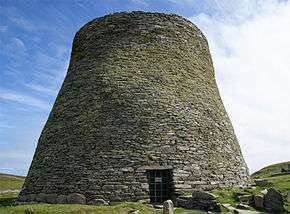Flow Country
| Location | In Caithness and Sutherland in the far north of Scotland. |
| Type | Bog |
| Water | Acid fresh |
| Area | 4000 km2. (1540 square miles) |
The Flow Country is a large, rolling expanse of peatland and wetland area of Caithness and Sutherland in Scotland. It is the largest expanse of blanket bog in Europe, and covers about 4,000 square kilometres (1500 mile2).

The area is home to a rich variety of wildlife, and is used as a breeding ground for many different species of birds, including greenshank, dunlin, merlin and golden plover.
The Flow Country was badly damaged between 1979 and 1987 through the planting of non-native conifer forests and the cutting of thousands of miles of drains.[1] The trees dried out the peat, changing the habitat and destroying its value for birds and other wildlife. The trees were mostly planted on land bought by Fountain Forestry who recognised that this would be attractive to wealthy investors who could claim planting grants and tax relief against all their other income, at a time of high personal taxation. The ploughing of the bogs and tree planting helped to reduce local unemployment which was among the highest in the United Kingdom: however in 1987 the Nature Conservancy Council (NCC) launched a report in London that was highly critical of the foresters. The Conservative Party which was in government at the time decided to disband the NCC and create a separate Scottish agency now called Scottish Natural Heritage. However, in 1988 Nigel Lawson, The Chancellor of the Exchequer, recognised that a tax break was doing enormous harm to the last real wilderness in the United Kingdom and scrapped the forestry tax reliefs. This immediately halted further planting and encouraged the Forestry Commission to adopt a much broader approach that respects existing landscapes. In an effort to restore the damage, the Royal Society for the Protection of Birds (RSPB) have bought a large area in the centre of the Flow Country and have created the Forsinard nature reserve. More than 20 km2 has been bought back from Fountain Forestry and the young trees felled and allowed to rot in the plough furrow in the hope and expectation that, in 30 to 100 years, the land will revert to peat bog.
The Flow Country is on the 2006 UK "tentative list" as a possible UNESCO World Heritage Site.[2] The application was re-listed in 2010 and Stuart Housden, the director of RSPB Scotland and a member of the Rural Development Council, said, "This largely unspoilt landscape has thousands of hectares of ancient blanket peat land, making this perhaps the most important area of its type in the Northern Hemisphere. A global badge would certainly help us to get this special place in better heart. This area was sorely threatened in the 1980s and early 1990s by inappropriate afforestation, but just in time a conservation campaign mounted by the RSPB stopped the worst excesses. Action is now underway to restore the area."[3]
Rail access
The Far North Line connects into Forsinard station serving the area.
References
- ↑ McCarthy, Michael (2006-06-24), "Planting forests is a Good Thing, right?", The Independent, retrieved 2008-11-24
- ↑ Historic Scotland - UK Tentative List Retrieved 03.01.2007.
- ↑ Ross, Sian, (8 July 2010) "Scotland's best: Bridge and bogs seek place among world wonders." Edinburgh: The Scotsman.
External links
Coordinates: 58°22′17″N 3°39′30″W / 58.371478°N 3.658447°W
